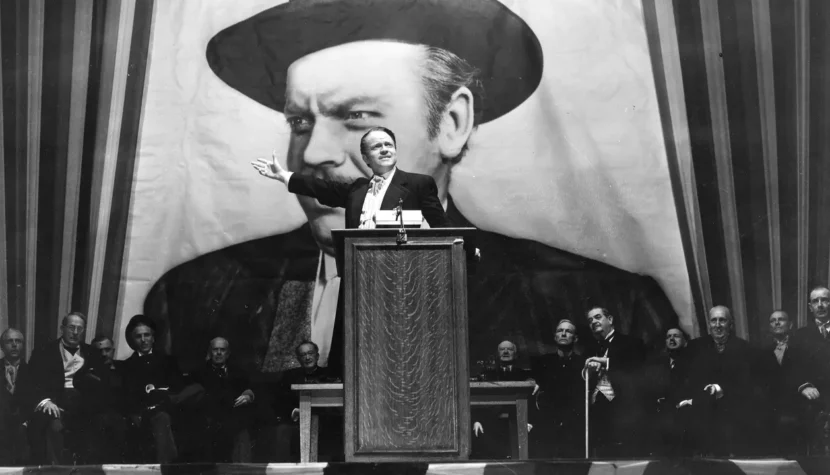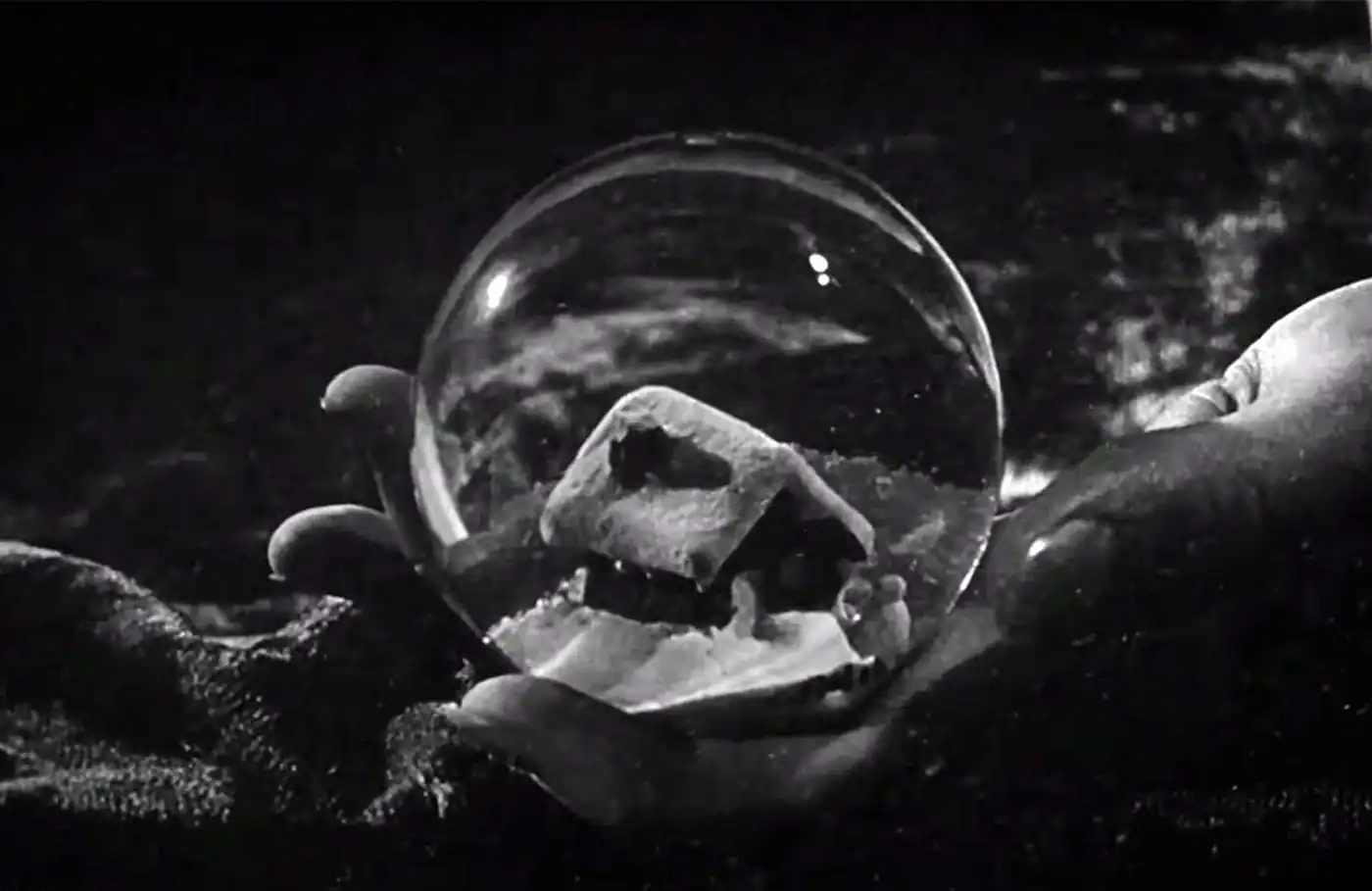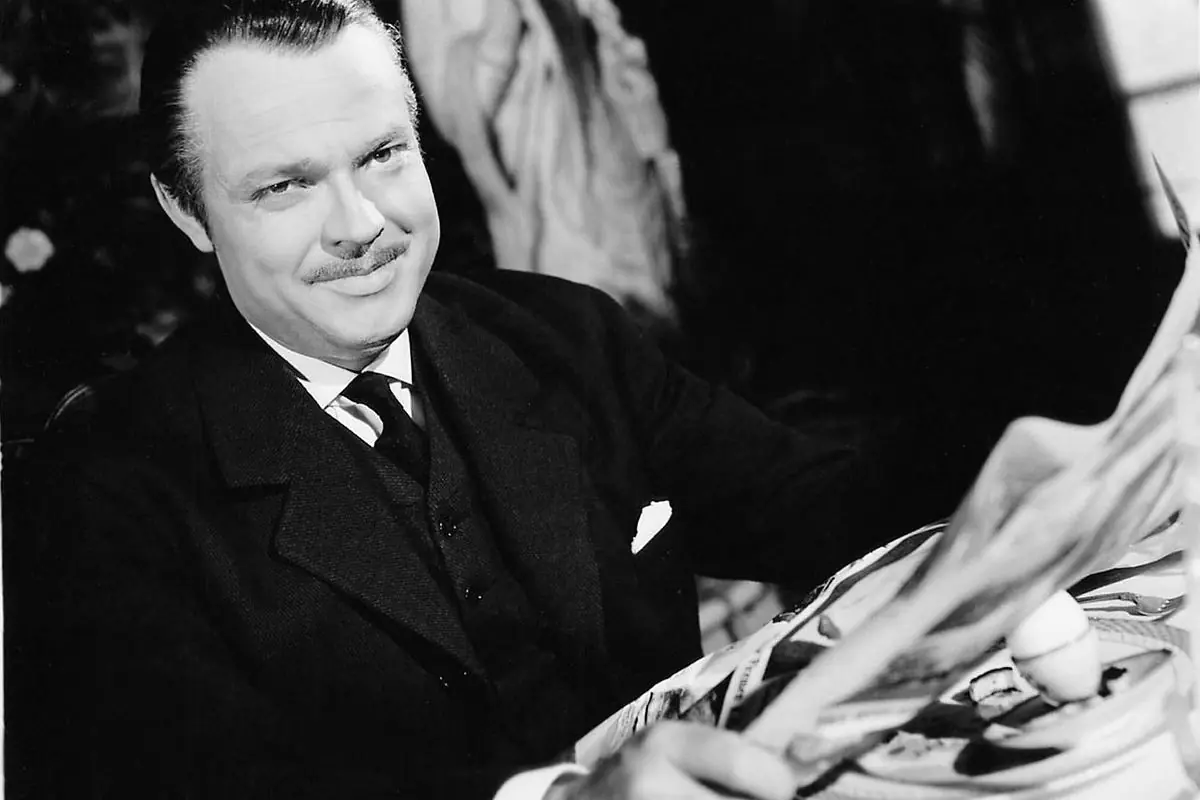CITIZEN KANE: Silence! The Best Film Ever Made!

To face a legend – this is the dream and nightmare of every more or less experienced, professional or non-professional reviewer. How do you write about a film that has become a canon of world cinema and a textbook for film students worldwide? But on the other hand, how do you not write about such a film? Citizen Kane is that film.

It begins with the scene of the lonely death of an elderly man (at this point, we still do not know who he is) who utters his last word: Rosebud and drops a glass ball – a paperweight. This scene, although shown only once in the film, will accompany us until the very end because of the last words spoken by the man. In the next shot, there is a surprise – we see a newsreel from which we learn who the elderly man was, and he was no ordinary man – a press tycoon who permanently etched his name in American history. He is Charles Foster Kane (played excellently by Orson Welles). The newsreel briefly presents the story of this extraordinary man from his birth to his death.

Orson Welles used a stylistic device here that, at the time, was completely unknown – in the first minutes of the film, he showed the ending and a shortened story of the life of the main character. By doing this, he disrupted the linearity of the narrative, which was unheard of at that time. This might give the viewer the impression that there is nothing more to tell. Nothing could be further from the truth. Welles makes it clear to the viewer that it is not the biography of the hero that is of interest, but the reasons that led to such an ending. At the end of the newsreel, the viewer is transported to the screening room, among the editors – the authors of the material just watched. The head of the team – the director – is, however, not satisfied with the result and demands something special from his subordinates – an explanation of the meaning of the last word spoken by Kane before his death – Rosebud. To achieve this, he sends a reporter whose task is to learn as much as possible about it. To do so, the reporter will talk to people who were closest to Charles Foster Kane. This is where the “action” of the film truly begins.

Citizen Kane is a series of flashbacks, each of which results from the reporter’s meeting with another person from Kane’s circle: the manager of The Inquirer, Bernstein, his friend Leland, his wife Susan Alexander, and the butler (an exception is Thatcher – Kane’s legal guardian, and his meeting is replaced by reading entries from his diary). Interestingly, although the reporter seems to be an important character in the story, Welles never shows his face (just as he does not show the faces of the director/editor who assigned him the task), we only know his last name (Thompson) and hear his voice. The director seems to be saying that in this story, the focus should not be on them. From the storytelling of each person, a slightly different portrait of the main character emerges, enriched with new details that complement his image.

We meet Kane in 1871, as a young boy. We learn that, due to a provision in the will of one of the motel’s clients, which is run by his mother, the boy inherits a gold mine in Colorado and a fortune, but on the condition that he is placed under the care and upbringing of a bank representative who manages the bequeathed fortune. The creator clearly suggests that the mother agrees to give up the child in order to minimize his contact with his father. This is an extremely important scene for the structure of the film, a scene that will ultimately become the key to solving the mystery of Charles Foster Kane. Welles weaves a story about the life of the press tycoon, owner of dozens of newspapers, radio stations, printing houses, and ocean liners. We learn about his first and most important newspaper, The Inquirer, his environment, aspirations, friend, wives, his brief political career, and finally the story of his symbolic downfall.

The film gradually takes us through the story of a great man, leading us from his childhood, through youth, adulthood, to old age and finally death. As we get familiar with Kane’s story and personality, we begin to understand what drives him, the motives behind his actions become clear. A truly surprising image emerges from this – an image of a man, an idealist, who could not withstand the test that life put before him, became bitter, and… lonely (the final proof of his loneliness is the inaccessible Xanadu mansion where he lived). There is a scene in the film where Kane, along with his friend Leland and members of the editorial staff, work on the contents of the front page of The Inquirer, which Kane owns and serves as editor-in-chief. Kane places a Declaration of Principles on the front page – a set of rules that are to form the foundation of the newspaper’s operations.

It is a symbol – a declaration of fidelity to the principles. Years later, Leland sends the Declaration back to Kane, and he tears it up, ultimately breaking with the ideals of his youth. At that point, we know that Charles Foster Kane has lost his life’s battle. However, Orson Welles does not stop at telling the story, but also points to the cause of his downfall. What is it? It may sound trivial, but it is… the lack of love. Kane cannot love, hurt by his father, deprived of maternal warmth at the age of a few years, raised by the bank – he cannot love. In the film, the theme of unfulfilled love persists, the hero, deprived of it in childhood, tries to find a substitute for it with his wife, tries to buy it from his voters. At the same time, he is too greedy, and moreover, he cannot evoke it from within himself. For the same reason, he destroys his (only) friendship with Leland, and eventually ends up alone and dies alone. Rosebud. What is it? In one of the final shots of the film, the director shows the child’s sleds burning in the furnace by workers who are cleaning Kane’s estate after his death. In a close-up, we see a drawing and a signature – Rosebud. The sleds are another symbol – the lost childhood, the longing for home warmth, a mother’s love; or maybe simply… the longing for normalcy.

Someone might ask – what is this film about? About the lack of love, about friendship, corruption, the fall of ideals, loneliness, or perhaps the power of money? My answer is – I don’t know. Everyone can interpret and read it in their own way. That is its greatness.
Citizen Kane was created in 1941 by 25-year-old director Orson Welles, who by that time was already well-known for his theatrical and radio achievements (including the famous radio play War of the Worlds). It was his film debut. Many film critics claim that despite his genius, he never again reached the level he presented in Citizen Kane. The film was not well received by either the public or contemporary critics. Today, we would say that it was ahead of its time, or perhaps showed a phenomenon that to this day is very reluctantly portrayed by mainstream filmmakers. Kane’s attitude is contrary to the American dream, he is a man who inherited a fortune, did not have to start from scratch, and moreover, did not build anything, as he himself says – I only bought. It is not surprising, then, that this attitude was not to the liking of American filmmakers accustomed to waving flags.

The film is loosely based on the biography of the famous press baron William Randolph Hearst, who, with the help of his media empire, also contributed to effectively deterring the public. Legend has it that Hearst offered the film’s producer – RKO – to buy and destroy all copies of the film in exchange for a full refund of the costs. We can only be glad that this never happened. However, after this, no Hollywood studio ever allowed Welles to take full artistic control over a film again.

Citizen Kane became almost a tutorial film for later filmmakers for a reason. Welles introduced a completely unknown narrative technique, abandoning the linearity of the plot in favor of flashbacks describing the inner development of the character. The filming technique used, the construction of deep shots (large depth of field), strong, expressive use of light and shadow visible in the excellent cinematography by Gregg Toland, and the wide use of what Welles called intra-frame editing (long staged shots with few cuts) made this film a breakthrough in filmmaking technique. The unique atmosphere, the sense of mystery, and above all, the universal story supported by flawless execution are what make Citizen Kane still surprisingly relevant.

Citizen Kane opens and closes with the same shot, showing the fence of Xanadu estate with a sign that reads No trespassing. This symbolic sign closing the world of Charles Foster Kane and separating him from any external influences should not discourage potential viewers of this classic film. It is worth taking the risk and crossing this boundary to see firsthand how the history of world cinema was created.

